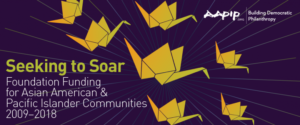BY TFN STAFF
Earlier this spring, Asian Americans/Pacific Islanders in Philanthropy released a report examining the level of foundation investments in AAPI communities — and whether it has kept pace with changing demographics and needs over the past three decades.
The report was released in the wake of the deadly and racially motivated attacks on Asian-owned businesses in Atlanta, part of a disturbing uptick in anti-Asian violence during the pandemic that has been fueled by rhetoric wrongly blaming Asians for the spread of COVID and tapping into long-held xenophobia and racism against AAPI communities.
As part of Asian American and Pacific Islander Heritage Month, and in keeping with The Funders Network’s commitment to encourage investment and philanthropic leadership that supports racial equity, we are sharing this study with our TFN audience. (We also invite you to read this blog post from TFN PLACES Alum Jonathan Hui of The Kresge Foundation, sharing his experiences as an immigrant from Hong Kong and reflecting on the role philanthropy can play in supporting the AAPI community.)
According to AAPIP’s report, Seeking to Soar: Foundation Funding for Asian American & Pacific Islander Communities, “foundation funding designated for Asian American and Pacific Islander (AAPI) communities only accounts for 0.20 percent of all U.S. grantmaking.”
Or, as the report further notes: “[f]or every $100 awarded by foundations for work in the United States, only 20 cents is designated for AAPI communities.”
While the population of Asian Americans and Pacific Islanders in the U.S. has seen substantial growth, foundation funding for AAPI communities flatlined — and those funding dollars are “heavily concentrated among a handful of foundations” that account for nearly 40 percent of all philanthropic support for AAPI communities, according to the AAPIP report.

While the report focuses on the period between 2009 and 2018, the ongoing coronavirus pandemic and its impacts on the AAPI community have thrown the data into sharp relief.
As AAPIP’s President and CEO Patricia Eng and Interim Vice President of Programs Lyle Matthew Kan note in the report’s introduction:
“Similar to the experiences of Black, Latinx, and Native American communities, Asian Americans and Pacific Islanders have been and continue to be disproportionately impacted by the pandemic. COVID-19 infection rates for Pacific Islanders were consistently among the highest in the country, undercounted and hidden without the magnifying glass of disaggregated data. As the country shut down, Asian American unemployment rates increased by more than 450 percent from February to June 2020, the highest rate of increase of any racial group. Moreover, nearly one in four Asian Americans were employed as frontline workers — risking their own health and safety to stem the tide of the infection and get the country back on track.”
They further note that “[i]n the face of great disparities and challenges, the fact that the percentage of philanthropic dollars designated for AAPIs has not moved in at least three decades, is cause to raise many eyebrows.”
You can read more key takeaways, download the full report, and access infographics from the report via the AAPIP website.
More resources and information from AAPIP
- Register for their May 24 webinar, Invisible Ink – AAPI Representation in the Media & Perpetuation of the Model Minority Myth
- Read this open letter to philanthropy, A Call for Solidarity and Collective Action: Asian American Philanthropy Letter of Intention
- Visit AAPIP’s Supporting API Communities Resource Directory, created to mobilize the philanthropic sector towards meaningful action in the midst of heightened violence and hate targeting Asian American communities.
“Origami – order out of chaos” by docoverachiever is licensed under CC BY
